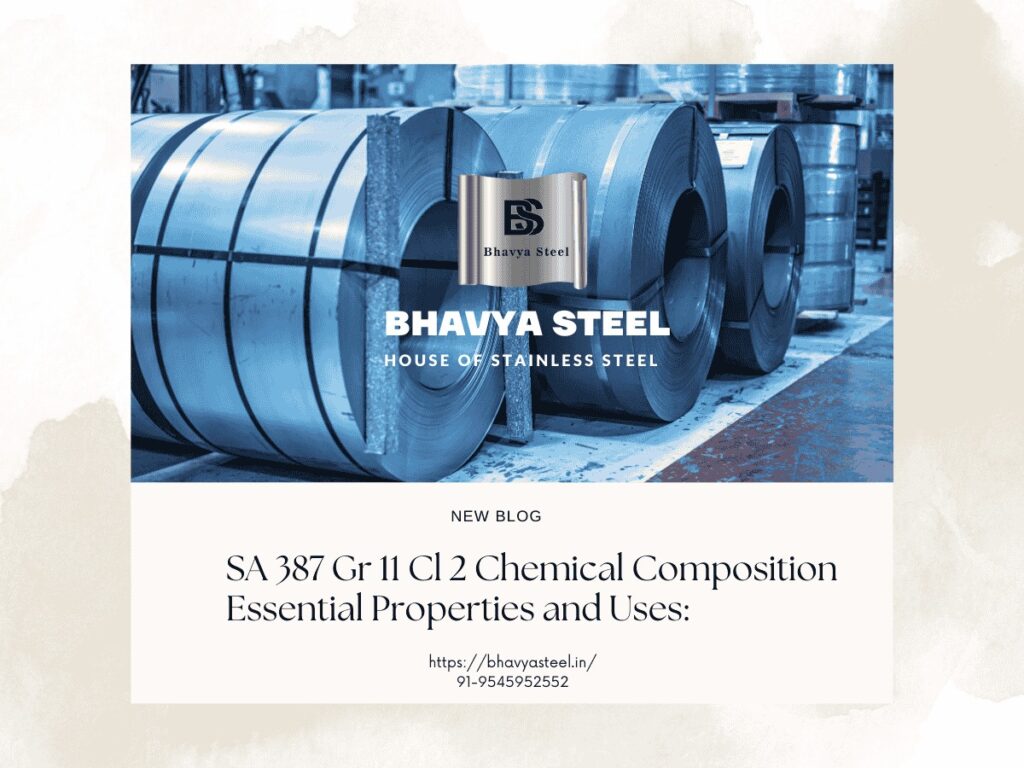
Understanding the Mechanical Properties of SA387 Grade 11 Alloy Steel
Alloy steels have become indispensable in various industries, offering a blend of strength, durability, and resistance to extreme conditions. Among these, SA387 Grade 11 Alloy Steel stands out, particularly in the petrochemical, oil and gas, and power generation sectors. This blog delves into the mechanical properties of SA387 Grade 11 Alloy Steel, exploring its composition, heat treatment, and applications.
- Composition of SA387 Grade 11 Alloy Steel
SA387 Grade 11 is a chromium-molybdenum alloy steel, a combination that lends the material its strength and resistance to heat. The key elements in its composition include:
- Chromium (Cr): Typically around 1-1.5%, chromium enhances corrosion resistance and adds to the material’s hardness.
- Molybdenum (Mo): Around 0.45-0.65%, molybdenum increases strength, toughness, and resistance to wear and high temperatures.
- Carbon (C): Ranging from 0.05-0.17%, carbon content influences the hardness and strength of the steel.
- Manganese (Mn), Phosphorus (P), Sulfur (S), and Silicon (Si): These elements are present in smaller quantities, contributing to the overall durability, machinability, and resistance to environmental factors.
This precise chemical composition is crucial in defining the mechanical properties of SA387 Grade 11, allowing it to perform effectively in demanding environments.
- Mechanical Properties of SA387 Grade 11 Alloy Steel
The mechanical properties of SA387 Grade 11 Alloy Steel are what make it a preferred choice in high-stress environments. These properties include:
- Tensile Strength: The tensile strength of SA387 Grade 11 typically ranges from 485 to 620 MPa. This property is vital as it indicates the maximum amount of stress that the material can withstand while being stretched or pulled before breaking.
- Yield Strength: Yield strength ranges from 275 to 415 MPa, marking the point at which the steel begins to deform plastically. Beyond this point, the material will not return to its original shape. This property is essential for applications where maintaining structural integrity under stress is critical.
- Elongation: The elongation of SA387 Grade 11 is usually around 20%, showing its ability to deform under tensile stress before fracturing. This property is particularly important in applications where flexibility is required without compromising strength.
- Hardness: While the hardness of SA387 Grade 11 Alloy Steel varies depending on heat treatment and working conditions, it generally exhibits a Brinell hardness of approximately 150-200 HBW. This level of hardness is sufficient for resisting wear and tear, ensuring longevity in high-stress applications.
- Impact Resistance: The impact resistance, often measured using Charpy V-notch tests, is another critical property. SA387 Grade 11 offers excellent impact resistance, particularly at elevated temperatures, making it suitable for applications that involve rapid temperature changes or where the material must absorb energy without fracturing.
- Heat Treatment and Its Effects on Mechanical Properties
Heat treatment is a vital process in enhancing the mechanical properties of SA387 Grade 11 Alloy Steel. The common heat treatment processes include annealing, quenching, and tempering, each of which can significantly alter the material’s properties:
- Annealing: This process involves heating the steel to a high temperature and then allowing it to cool slowly. Annealing improves ductility and reduces hardness, making the material easier to work with during fabrication.
- Quenching: Quenching involves heating the steel to a specific temperature and then rapidly cooling it in water or oil. This process increases the steel’s hardness and strength but can also make it more brittle.
- Tempering: After quenching, tempering is often used to reduce the brittleness while maintaining strength. Tempering involves reheating the steel to a temperature below its critical point and then allowing it to cool. This process enhances toughness, making the material more resilient to impact and stress.
The specific heat treatment process used depends on the intended application of the SA387 Grade 11 Alloy Steel. For example, in pressure vessels where toughness and resistance to thermal stress are crucial, tempering is often the preferred method.
- Applications of SA387 Grade 11 Alloy Steel
The exceptional mechanical properties of SA387 Grade 11 Alloy Steel make it suitable for various applications, particularly in industries where high temperatures and pressures are common:
- Petrochemical Industry: SA387 Grade 11 is widely used in the construction of pressure vessels and heat exchangers in the petrochemical industry. Its ability to withstand high temperatures and corrosive environments makes it ideal for processing and storing chemicals and gases.
- Power Generation: In power plants, especially those that utilize fossil fuels, SA387 Grade 11 Alloy Steel is used in boilers and other components that are exposed to high temperatures and pressures. Its durability ensures long-term performance even under the most demanding conditions.
- Oil and Gas Industry: The oil and gas sector relies heavily on SA387 Grade 11 for pipelines, pressure vessels, and other critical components. The material’s resistance to hydrogen-induced cracking and sulfide stress corrosion is particularly valuable in this industry.
- Industrial Boilers: SA387 Grade 11 is also used in the manufacture of industrial boilers, where its ability to withstand high pressure and temperature is essential for safe and efficient operation.
- Conclusion
SA387 Grade 11 Alloy Steel is a material designed to perform in environments that demand both strength and resilience. Its mechanical properties, shaped by its unique chemical composition and heat treatment processes, make it a cornerstone in industries such as petrochemicals, power generation, and oil and gas. Understanding these properties is crucial for engineers and industry professionals who seek to harness the full potential of this alloy in their projects.
Whether it’s resisting high temperatures, enduring stress, or maintaining structural integrity under pressure, SA387 Grade 11 stands out as a reliable and robust choice. As industries continue to push the boundaries of what materials can achieve, the significance of understanding and utilizing the mechanical properties of SA387 Grade 11 Alloy Steel cannot be overstated.